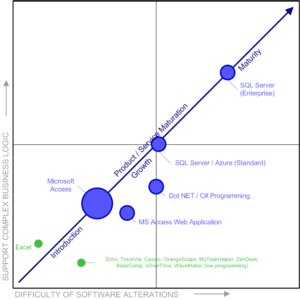Fuel your business growth by choosing the right technology at the right time.
The Microsoft Access ecosystem is comprised of many products and services. Knowing which to use and when insures strong business growth.
Our intention is to arm our customers with the right information so they can make informed decisions.
Before deciding to build a custom database application, please read this article which walks you through the steps in the buy vs. build decision tree.
Rule of thumb
If the new product or service you are seeking to buy or build is unique to your business and makes you competitive in the marketplace, then there will not be an existing off-the-shelf software package or Software As a Service (SaaS) which will be adequate to support your long-term business growth nor should you tie your businesses growth to depending on another company’s product. There, BUILD, else BUY.
A custom database application is a strategic asset to your organization and adequate investment is key to beating the competition. An annual budget approved by executive management is critical to the long-term development and growth of the busienss.
Finding the sweet-spot among many technologies to leverage supporting your business growth
There are three stages in the product or service lifecycle: 1) introduction, 2) growth, and then finally, 3) maturity.
The best technology for each stage depends on two major business requirements: 1) the rate of business change, and 2) the complexity of the business logic.
#1. Rapid change requires a rapid application development platform such as Microsoft Access.
#2. Business Logic: Low complexity support is provided by Microsoft Excel, where as medium to high complexity is supported by Microsoft Access. Ultra-high and mission critical levels of complexity are better supported by products such as backend database technologies such as Oracle, SQL Server and Sybase while front-end technologies which support the highest complex business logic are C++, C#, VBA (in MS Access), dot NET, Java and others.
The least total cost of ownership (TCO) (development + support) results when you chose the right technology for the particular phase (introduction, growth, maturity) you are solving for in the product or service maturity lifecycle.
In general, you want to select easy to modify technologies when future application changes will be frequent and gradually migrate mature portions of the application to more complex and scalable technologies when the business requires higher performance.
For example, you wouldn’t chose a technical stack comprised of enterprise technologies such as Java/Web Services on an Oracle database application running on UNIX when you have a simple 3 person team needing a desktop application to track their internal budgeting for holiday parties. The reverse is true too, you wouldn’t want to use Microsoft Excel to implement an enterprise wide financial systems for a company with 50,000 employees.
Therefore, the technical sweet-spot is defined as the the right technology choice for a product or service’s current business requirements. There is no right technology for every stage in the lifecycle for custom database applications. The technical sweet-spot changes as the product or services moves through it’s lifecycle from introduction, to growth and finally, into maturity.

Product/Service technical lifecycle – over time
Optimizing the product / service maturation towards maturity guarantees lowest total cost of ownership (TCO) and least capital investment.
Microsoft Access is often used in all three growth stages (introduction, growth, maturity) with only the level of it’s use changing over time. As a product / service move into growth and maturity, portions of the business logic are moved to more robust technologies while evolving business processes remain in the flexible MS Access platform.
Shifting Gears
To use an analogy, think about a formula race car going from zero to 200 miles an hour. Gear selection is easy; gear 1, then 2, then 3, etc. But exactly when to shift gears is key. Finding the ideal time to shift optimizes the final outcome – reaching maximum velocity. In your company you want to optimize return on investment when selecting the when to shift and which technology to shift into is key in increasing the velocity of your business growth. A miss-shift and you risk losing the race.
Gear Selection
The remainder of this webpage is designed to help you chose which gear to shift into next.
Pre – Introduction
Buy vs. Build Decision Tree
Sites designed to help you find Software As a Service (SaaS) alternatives:
www.SoftwareAdvice.com (By Gartner)
www.G2Crowd.com
www.SoftwareSuggest.com
Gartner Decision Tools for Vendor Selection (pdf)
www.selecthub.com
Introduction
Microsoft Excel, Zoho, TrackVia, Caspio, OrangeScrape, MyTaskHelper, ZenDesk, BaseCamp, xOvertime, WaveMaker, etc. (more to come)
Growth and Maturity
Microsoft Access, (more to come).
Help4Access Migration Services
Helping you make the shift
5 Guild Tools + Consulting Services = Positive Success
- Help4Access – Microsoft Access DiscoverAccess™ software tool.
- Help4Access – Microsoft Access Roadmap to Maturity™ framework.
- Help4Access – Microsoft Access Solution Building Blocks™ code library.
- Help4Access – Microsoft Access MigrateAccess™ software tool.
- Help4Access – Microsoft Access Change Management using Azure DevOps©
Help4Access will help you navigate this complex ecosystem. Schedule a Call


